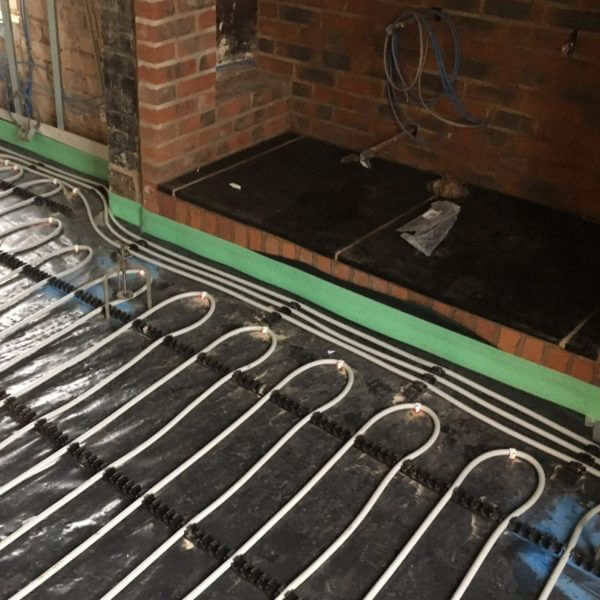Underfloor Heating Vs Infrared Heaters
In the world of electric heating, infrared heating panels and radiators are becoming more prominent. They work differently from traditional electric heating, and underfloor heating, providing a series of advantages – and disadvantages – to heating a home. Which is the more efficient heating option for a home, and what key issues must you consider?
Underfloor Heating vs. Infrared Heating
| Factor | Underfloor Heating | Infrared Heating |
| How it works | A heat source and manifold distribute heated water across a network of pipes which heat rooms evenly. | A heater emits artificial infrared radiation, which converts into heat when it comes in contact with a solid object or person. |
| Its best feature | Warm, comfortable floors. | A fast feeling of warmth. |
| How hot it runs | The flow temperature in the pipes operates around 40°C. | Depending on intensity, heaters can reach 90°C. |
| Longevity | Lasts up to 50 years. | Lasts between 20–30 years. |
| Space considerations | Increased floor height with no exposed components. Requires minimal floor clutter. | Ceiling or wall space required to host heaters. Requires clear space without obstructions. |
| Cost efficiency | Highly efficient and compatible with heat pumps. | Cost-efficient on a small scale. |
| Zoning | Possible by linking manifold circuits to a thermostat. | Heaters are individually controlled, larger zones may require Wi-Fi compatibility. |
| Maintenance | Annual servicing of the heat source and manifold is recommended. | No regular maintenance needs, but repairing faults can be difficult. |
| Smart home compatibility | Requires smart home compatible thermostats. | Requires panels already compatible with Wi-Fi. |
| Ease of installation | Can be complex to install, depending on the property. | Easy to install, but with safety considerations to navigate when deciding placement. |
| Cost of installation | Cheaper in large-scale applications. Costs an average of £90-180 per m², depending on the property. | Cheaper in small scale applications. Costs an average of £200-£600 per heater. |
| Potential risks | Risk of developing leaks. Poor quality installations may result in hot/cold spots. | Hot spots on objects and surfaces. Potential electrical faults, fire hazards, and burn hazards to mitigate. |
| Best for | Full heating refurbishments, homes with heat pumps, and large extensions. | Bathrooms, conservatories, patios, or small extensions. |
How Infrared Heating Works
Traditional electric heating uses electricity to heat wires, which produce radiant heat that warms up a space. In an infrared system, electricity is converted into artificial infrared radiation. This radiation converts into heat when it comes in contact with objects or persons, which then radiates off into the air, heating the room.
Is Infrared Heating Safe?
For the most part it is, but there are some risks to mitigate. The panels and radiators used in infrared become extremely hot, up to 90°C, which can be a severe burn risk. The heating can also be a fire hazard risk if obstructed, or if a flammable object is placed within 30-40cm of the heater.
The health risks of long-term infrared heating exposure are still being studied. The good news is that artificial infrared cannot cause sunburns because it emits no UV radiation, but artificial infrared radiation has been shown to cause skin damage, inflammation, and be detrimental to sensitive skin conditions. This was observed particularly in high intensity/high wattage applications.
What are the Disadvantages of Infrared Heating?
It’s not very efficient heating. While you feel warm soon after it is turned on, this is from the conversion of infrared radiation into heat on your skin and clothes. Infrared radiation doesn’t heat the air, it counts on the objects it comes into contact with to radiate heat and warm a room.
You may also require multiple panels for large living rooms and open-plan areas to ensure even heating. It takes just as long for the infrared heater to warm a room to a desired temperature as underfloor heating, if not longer. As a result, you are facing quite high utility bills, no different from other electric heating systems.
There is also the cost of installation to consider. A single infrared panel that mounts to the ceiling with smart heating compatibility can cost as much as £600. Cheaper infrared heaters lack thermostat or programming controls, which is not ideal for use as part of a central heating system.
How Underfloor Heating Works
Underfloor heating works very similarly to traditional radiators, where hot water is distributed through pipes. Unlike traditional radiators, these are designed as circuits that run underneath the floor. This takes advantage of the fact that heat naturally rises to ensure a room is heated evenly.
Is Underfloor Heating Safe?
Underfloor heating is one of the safest ways to heat your home, provided you trust a quality installer. No exposed parts means no risk of burns, and provided you maintain your heat source, the risk of fire is minimal.
What are the Disadvantages of Underfloor Heating?
Compared to infrared heating, it takes longer to feel the benefit of the heat when it rises naturally from the floor up. While this heats the room evenly, it can be delayed if there is floor clutter that would prevent heat from rising.
It also has a significant installation cost, depending on the floor layout, amount of floor insulation needed, as well as the amount of liquid screed needed to cover the pipes. Poor quality installations can result in reduced performance or maintenance issues. That said, these are mitigated by the fact that it is very efficient heating, both in terms of utility bills and carbon emissions.




Where To Find Us